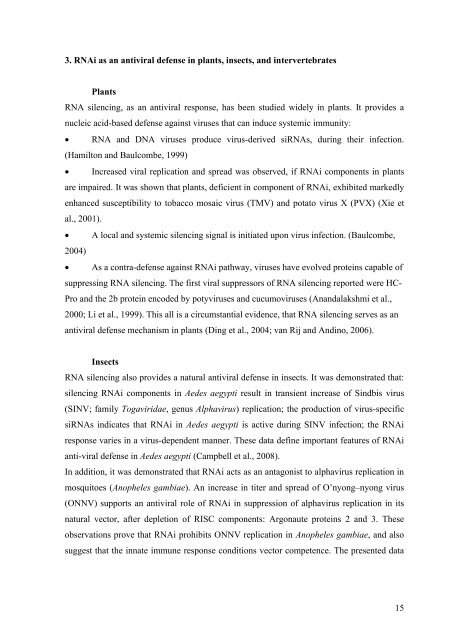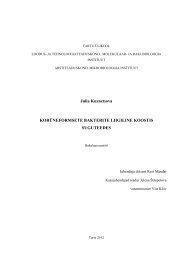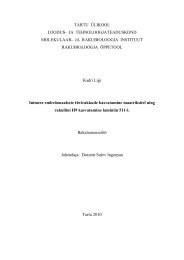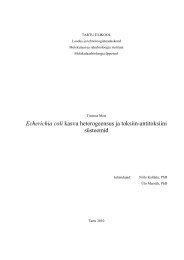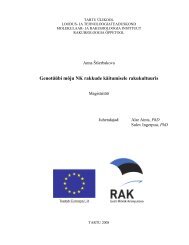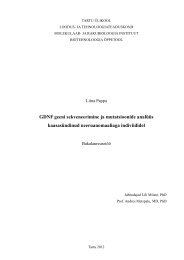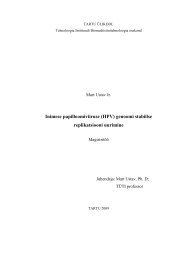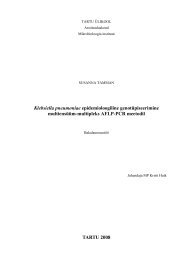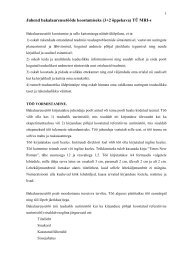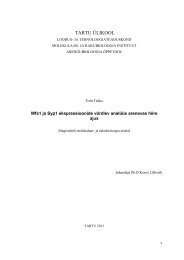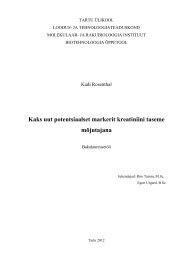Viruses and RNA interference in mammalian cells
Viruses and RNA interference in mammalian cells
Viruses and RNA interference in mammalian cells
You also want an ePaper? Increase the reach of your titles
YUMPU automatically turns print PDFs into web optimized ePapers that Google loves.
3. <strong>RNA</strong>i as an antiviral defense <strong>in</strong> plants, <strong>in</strong>sects, <strong>and</strong> <strong>in</strong>tervertebrates<br />
Plants<br />
<strong>RNA</strong> silenc<strong>in</strong>g, as an antiviral response, has been studied widely <strong>in</strong> plants. It provides a<br />
nucleic acid-based defense aga<strong>in</strong>st viruses that can <strong>in</strong>duce systemic immunity:<br />
<strong>RNA</strong> <strong>and</strong> DNA viruses produce virus-derived si<strong>RNA</strong>s, dur<strong>in</strong>g their <strong>in</strong>fection.<br />
(Hamilton <strong>and</strong> Baulcombe, 1999)<br />
Increased viral replication <strong>and</strong> spread was observed, if <strong>RNA</strong>i components <strong>in</strong> plants<br />
are impaired. It was shown that plants, deficient <strong>in</strong> component of <strong>RNA</strong>i, exhibited markedly<br />
enhanced susceptibility to tobacco mosaic virus (TMV) <strong>and</strong> potato virus X (PVX) (Xie et<br />
al., 2001).<br />
A local <strong>and</strong> systemic silenc<strong>in</strong>g signal is <strong>in</strong>itiated upon virus <strong>in</strong>fection. (Baulcombe,<br />
2004)<br />
As a contra-defense aga<strong>in</strong>st <strong>RNA</strong>i pathway, viruses have evolved prote<strong>in</strong>s capable of<br />
suppress<strong>in</strong>g <strong>RNA</strong> silenc<strong>in</strong>g. The first viral suppressors of <strong>RNA</strong> silenc<strong>in</strong>g reported were HC-<br />
Pro <strong>and</strong> the 2b prote<strong>in</strong> encoded by potyviruses <strong>and</strong> cucumoviruses (An<strong>and</strong>alakshmi et al.,<br />
2000; Li et al., 1999). This all is a circumstantial evidence, that <strong>RNA</strong> silenc<strong>in</strong>g serves as an<br />
antiviral defense mechanism <strong>in</strong> plants (D<strong>in</strong>g et al., 2004; van Rij <strong>and</strong> And<strong>in</strong>o, 2006).<br />
Insects<br />
<strong>RNA</strong> silenc<strong>in</strong>g also provides a natural antiviral defense <strong>in</strong> <strong>in</strong>sects. It was demonstrated that:<br />
silenc<strong>in</strong>g <strong>RNA</strong>i components <strong>in</strong> Aedes aegypti result <strong>in</strong> transient <strong>in</strong>crease of S<strong>in</strong>dbis virus<br />
(SINV; family Togaviridae, genus Alphavirus) replication; the production of virus-specific<br />
si<strong>RNA</strong>s <strong>in</strong>dicates that <strong>RNA</strong>i <strong>in</strong> Aedes aegypti is active dur<strong>in</strong>g SINV <strong>in</strong>fection; the <strong>RNA</strong>i<br />
response varies <strong>in</strong> a virus-dependent manner. These data def<strong>in</strong>e important features of <strong>RNA</strong>i<br />
anti-viral defense <strong>in</strong> Aedes aegypti (Campbell et al., 2008).<br />
In addition, it was demonstrated that <strong>RNA</strong>i acts as an antagonist to alphavirus replication <strong>in</strong><br />
mosquitoes (Anopheles gambiae). An <strong>in</strong>crease <strong>in</strong> titer <strong>and</strong> spread of O’nyong–nyong virus<br />
(ONNV) supports an antiviral role of <strong>RNA</strong>i <strong>in</strong> suppression of alphavirus replication <strong>in</strong> its<br />
natural vector, after depletion of RISC components: Argonaute prote<strong>in</strong>s 2 <strong>and</strong> 3. These<br />
observations prove that <strong>RNA</strong>i prohibits ONNV replication <strong>in</strong> Anopheles gambiae, <strong>and</strong> also<br />
suggest that the <strong>in</strong>nate immune response conditions vector competence. The presented data<br />
15


